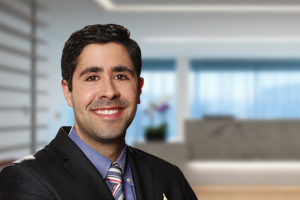Microtia is a congenital condition in which the ear does not develop properly. (The word microtia means “small ear.”) Microtia occurs about once in every 6,000 to 12,000 births, with a higher frequency among Hispanics, Asians, Native Americans, and Andeans.
The cause of microtia is not well understood, particularly the role of environmental and genetic factors. Genetics are thought to be a cause in only 5% of all patients. Multiple theories have been proposed to explain the cause of microtia during fetal development, such as neural crest cells disturbance, vascular disruption, and altitude, but these have not been proven.
It is important to understand that nothing a mother does during pregnancy, such as drinking coffee, alcohol use, or even drug abuse, has been shown to cause microtia. However, when taken in the first trimester of pregnancy, some medications like Thalidomide and Accutane have been linked to the condition.
Microtia usually occurs on only one side (more commonly on the right ear), but approximately 10% of patients have microtia on both sides (Bilateral Microtia).
Microtia is often seen as an isolated condition, but it may also occur with other syndromes including Hemifacial Microsomia, Goldenhar Syndrome, or Treacher Collins Syndrome. Other syndromes with microtia can also affect the kidneys, the heart, the eyes, the craniofacial bones, and the skeletal system. Children with these abnormalities are often cared for by a Craniofacial Team.
Microtia occurs in many different variations, ranging from just a small ear to complete absence of the ear, called anotia meaning “no ear.” In some cases, the ear canal is very small (aural stenosis) or absent (aural atresia). All types of ear surgery for microtia are technically difficult to perform. Most plastic surgeons would agree that ear reconstruction is one of the most challenging operations performed — requiring a combination of technical skill and artistry. The reason for this difficulty is related to the very complex shape that must be created for the ear in order for it to look natural.
Meet our Microtia Experts
John Reinisch, MD
A board-certified plastic surgeon and graduate of Harvard Medical School, Dr. Reinisch’s primary clinical and research interests focus on the field of pediatric plastic surgery and congenital ear deformities (microtia). He has treated more than 20,000 children from across the country and around the world. Central to Dr. Reinisch’s work is his emphasis on minimally invasive surgeries and personal, comfortable care, as well as his assurance that his patients and their families feel relaxed and confident throughout treatment. In 1983, Dr. Reinisch founded the Division of Plastic Surgery at Children’s Hospital Los Angeles, which is now one of the busiest departments at children’s hospitals in the world.
Dr. Reinisch is known worldwide for his design and development of the Medpor ear reconstruction technique. Traditionally, plastic surgeons have relied on a technique that removes cartilage from a patient’s chest and uses it to build the ear. The method, though effective, has two major limitations: It requires multiple surgeries to complete and cannot be performed until a child is 8-10 years of age – old enough to have a sufficient amount of rib cartilage. By this time, the effects of living with a deformity have often taken a toll on the child emotionally. Dr. Reinisch envisioned a new technique that would save children and their families the discomfort of multiple surgeries and the emotional distress a facial deformity can cause.
Dr. Reinisch designed a new method that relies on a biomaterial—not human—chest cartilage, and can therefore be implanted in children as young as age 3 in a single surgery, resulting in a better cosmetic outcome than rib cartilage ear reconstruction. By creating a new ear from the biomaterial and wrapping it in a thin layer of tissue from the patient’s scalp, Dr. Reinisch has overcome many of the obstacles of traditional ear reconstruction and has successfully treated more than 1,000 children. Since performing the first Medpor® surgery in 1991, Dr. Reinisch has further improved the technique by eliminating the need for drains after surgery, resulting in minimal scarring. More than 80 percent of his Medpor surgeries have required only one procedure.
Dr. Reinisch’s work with microtia and his creation of the Medpor® technique have won awards from both the American Association of Plastic Surgeons (AAPS) and the European Association of Plastic Surgeons (EURAPS). Most recently, he was the honored guest at the opening of the Smile Angel Foundation’s new children’s hospital in Beijing.
Dr. Reinisch is currently the Director of Craniofacial and Pediatric Plastic Surgery for Cedars-Sinai Medical Group in Los Angeles. When he began practicing in the 1980s, the field of pediatric plastic surgery was still in its infancy, and many children’s hospitals did not consider it a specialty. He is credited with establishing the Division of Plastic Surgery at the Children’s Hospital of Los Angeles, creating a model for other hospitals and serving as its Chief. He has also served as Head of the Division of Plastic Surgery at the University of Southern California (USC).
Youssef Tahiri, MD
Dr. Tahiri is a Board Certified Plastic and Reconstructive Surgeon with a subspecialty in Craniofacial Surgery. After graduating from McGill Medical School, in Montreal, Canada, he completed his Plastic and Reconstructive Surgery residency at McGill University and became certified by the prestigious Royal College of Physicians and Surgeons of Canada as well as the American Board of Plastic Surgery. During his residency, he demonstrated his commitment to research and academia by pursuing a Masters Degree in Experimental Surgery, which he obtained with Honors.
Following his training at McGill, Dr. Tahiri completed an ACGME accredited Pediatric and Adult Craniofacial Surgery Fellowship at the No.1 ranked Children’s Hospital of Philadelphia and at the prestigious Ivy League University of Pennsylvania.
After completing his Craniofacial Surgery training at the Children’s Hospital of Philadelphia and the University of Pennsylvania’s Hospitals, Dr. Tahiri joined the Division of Plastic and Reconstructive Surgery at Indiana University. He routinely performed complex reconstructive, aesthetic and complex craniofacial procedures at the Riley Hospital for Children as well as Methodist Hospital and Indiana University Hospital in Indianapolis.
After spending few years at Indiana University, Dr. Tahiri moved to Los Angeles to join Dr. Reinisch at Cedars Sinai Medical Center.
Dr. Youssef Tahiri is a highly respected pediatric craniofacial surgeon who was hand selected by Dr. John Reinisch to partner and continue his practice of Microtia reconstruction. Dr. John Reinisch is the founder of the Medpore ear reconstruction technique and is considered the worldwide leader in Medpore ear reconstruction.
Dr. Tahiri embraces the most innovative, cutting-edge technique available in craniofacial and microtia surgery.
Dr. Youssef Tahiri has published a very large number of peer-review articles and presented his work at numerous regional, national and international scientific meetings. His research interests include outcomes evidence based clinical studies and translational research to enhance patients’ care and safety through improved techniques and technology.
Dr. Tahiri specializes in Pediatric Plastic and Craniofacial Surgery as well as Adult Plastic, Reconstructive and Aesthetic Surgery.
